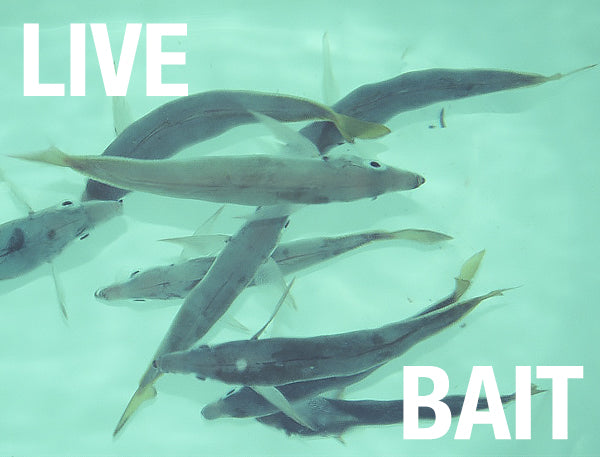
Live Bait Lucky Dipping

One of the best things about South East Queensland is its winter season- short and sweet without too much bitterly cold nastiness. We’re pretty much heading towards the end of the cold weather now though with only a couple weeks left, which leaves us fisherman with a few questions as to what we should be aiming to catch! I reckon we’ll be seeing maybe one or two more mackerel caught before they turn back on in December, but until then it’s definitely time to switch up tactics if you’re looking at getting into some fish a bit more consistently and one of the best ways to chase quality fish from your yak, especially when it’s otherwise a little bit slow, is with live bait.
Livies will be able to snare just about any large fish that can be caught at this time of year, whether it’s reefies like snapper or cod, pelagics like cobia or kingfish or evil ghost fish that can’t get caught ever like jewfish (or so I hear from people who don’t suck at catching them). A bit of variation in rigging is needed to effectively target any specific species, but by having a nice wriggling offering at the end of your line, your chances of a nice fish of some sort making its way to your hatch are definitely increased.

Midwater bait clouds- the dream!
Catching and Keeping the Bait
This is often by far the hardest part about this style of fishing. When searching for bait, it really is much, much, much easier if your kayak has a sounder- being able to see when a school of bait is underneath you really does make this task a whole lot easier. When looking for bait grounds I tend to favour areas with a bit of low, spread out structure often in slightly shallower water than my main fishing areas (that’s definitely not a hard and fast rule though!). Keep an eye out on the surface for any signs of activity and have your sabiki rig ready to go- sometimes it can be a good idea to cut them in half and just stick with 3 hooks to minimise tangles. Good quality live bait like yellowtail scad (yakkas) and slimey mackerel (slimies) will tend to show up as fairly densely packed clouds or lines on your sounder, usually raised off the bottom slightly or even sitting midwater. Once found, simply drop your jig straight into them, slowly lift the rod up and down and hope they’re chewing- if not, move on and find another school or try tipping your jig hooks with small pieces of bait (squid works great for this).
If you’re lucky enough to get your hands on some slimies make sure you treat them nicely by sticking them into a nice spacious livewell (the ones coming out in the new stealths will be just perfect for this), live bait tube or large collapsible bucket and either keep the water flowing cleanly or change it regularly as they aren’t the hardiest of fish, but once they’re rigged up and in the water you can be assured that nothing is more effective. If a predatory fish sees a live slimy mackerel that will (even barely) fit in its mouth, it will almost always eat it with minimal hesitation. Yakkas on the other hand are a bit easier to keep alive, but being a very spiky fish a lot of predators need to be a bit more careful about sizing up the bait and making sure they can swallow it headfirst. Other baits that can sometimes work are small trevally, whiptails or even small lutjanids and fusiliers, but always make sure that you’re sticking to size and bag limits as if you put it on a hook with the intention of having it eaten, it’s in your possession so always make sure you know what you’re putting on your hook. Also worth noting is that a bag limit of 20 applies to yakkas (although you would never need that many for a kayak trip!)

A typical Sabiki Rig
Rigging ‘em!
Rigging livies generally comes down to a few simple considerations: What size is your bait and what’s the largest fish that could eat it, where in the water column do you want to have it sitting and will you be paddling or drifting?
Bait size is probably the number one thing to consider when getting rigged up and ready to go. It’s quite important to match the size of your hook to the bait so that you can get good hook exposure while not making it too difficult for your livey to keep swimming. I find that 7/0 - 8/0 is a good starting point for circle hooks. This helps quite a lot in keeping your baits alive for longer and as such can be quite important to get right. The size of your bait will also determine how big your rod itself will need to be, with smaller yakkas or slimies able to be used on most offshore setups while bigger baits (around and over about 30cm or so) need a much more solid rod to be able to fish with them easily due to their added pull. Larger sinkers are also needed to keep bigger baits down if you’re aiming to fish down in the water column.
One of the best things about fishing with live baits is the simplicity with which they can be rigged. The fact that they can keep swimming upright by themselves means that they can be pinned simply through the nose and you’re in business. A single hook on the end of some leader (best attached with a swivel) is all that you need to fish with a livebait up near the surface, or you can add a running sinker or even one straight down to the hook and with the right sized sinker they will sit wherever you want them. These simpler rigs are best fished on a quick drift or while slowly paddling though as it can be difficult to keep your line tight and straight (a must when fishing with livies to avoid tangles) unless you’re moving forwards. If you’re going to fish sitting still on the other hand, a paternoster rig fished vertically under the kayak is the perfect way to keep your offering sitting right in front of the fish’s face!

Simple rigs like this account for plenty of quality fish
It’s also important to have a think about what fish are around where you’re fishing as this will play a significant role in determining your terminal tackle including your hook and leader size. If for example you are expecting big cobia to be on the cards, you’ll be wanting to beef your gear right up- good, big, strong hooks and heavy leader (70lb+) are a very wise choice just in case a 30+kg model decides to slurp down your bait. Snapper on the contrary are usually better target with smaller baits, hooks and lighter leaders, but with the exception of toothy fish like mackerel that require wire (which likely won’t be showing up for another couple of months), you should be able to find a happy medium which will work for most species of fish available in your chosen area at any given time.
A livey up on the surface tends to be a great way to chase cobia, kingfish and tuna or more summery species like marlin, mackerel or mahi mahi, whereas a nice midwater presentation will be deadly on snapper as well as cobia. If you’re fishing right on the bottom though expect the unexpected as plenty of different reef fish all might be on the cards!

Rigging heavy can be a wise choice!
Fishing with ‘em!
As mentioned, probably one of the biggest things to make sure of when fishing with live bait is to always keep a tight line where possible as if given slack they can often tangle other lines, rudders, themselves or even wriggle off the hook.
Drag setting on the other hand is a very personal thing with each person having different opinions for different reasons. I reckon just a normal strike drag is the way to go 90% of the time, but some swear by freespooling with the ratchet on for fish like marlin and kingfish to allow them to swallow a bait properly (particularly important with yakkas. If fishing close to hard reef, be ready to turn a fish away the moment you get a strike, but don’t lock it up from the get-go. Too heavy a drag with a rod in the holder and a vertical line is a classic mistake that can cause some pretty spectacular capsizes!

Try to not do a Rodney
Other than that however, it really is a very simple method of fishing. Just sit around in any area that you would fish with any other technique and hang on. Predators usually don’t struggle to find and lock in on a struggling live bait so by slowly covering a little bit of ground it shouldn’t be long before you hook up if the fish are there and on the chew!
Hopefully this has given you a bit of info to get you started! With the mackerel laying low and mono leaders becoming an option, now is definitely the right time of year to get out there and get stuck into some fish if you haven’t tried this method before.
Tight Lines,
Owen Gray.
